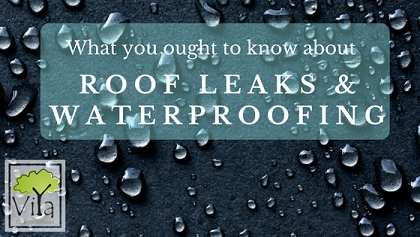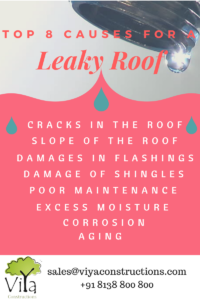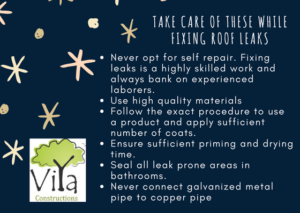Monsoon season can be dreadful if there is a dripping roof over your head. The leaky roof can cause a lot of trouble like health concerns to the occupants, damage to the interiors of the house, to name a few. Staying in a house with damp ceiling and plaster peeling off every now and then is a nightmare. To provide a permanent solution for roof leaks, it is necessary to first understand what is causing it.
Roof leaks – Causes and Prevention
What causes Roof Leaks?
Terrace is the part of house that is always exposed to climatic changes, be it the thriving south west monsoon, retreating monsoon or scorching summer. This continuous exposure can result in wear and tear of the roof that results in damage, causing leakage.
Moreover, roofs are constructed in major parts of Kerala using steel bar reinforced concrete mixture called as RCC. A flaw in mixing, casting or curing of RCC can negatively affect the strength of the roof, resulting in leaks as the building ages.
At Viya, we are committed to provide quality roofs that can stay for generations. And our experience so far has taught us the following as the common causes of leaky roofs:
- Crack in the Roofs – Over a period of time, the RCC shrinks forming cracks in the roof. A roof crack paves way for rain water to seep in to the house.
- Slope of the Roof – A leakage happens when the roof is not properly drained off. Mathematically for a roof to drain off the entire water, the slope has to be 1 in 40 for normal rainfall region and 1 in 20 for heavy rainfall regions.
- Damages in Flashings – The flashings that are used to prevent water from entering the house at joints or seams can get damaged over time. This happens with wear and tear, wind or other severe climatic conditions resulting in water penetration.
- Damage of Shingles – For shingled roofs, minor displacement of individual shingle, broken shingles or damage due to heavy rain, can result in rainwater to enter the layer beneath. This could be the triggering point for roof leaks.
-
Poor maintenance – If roofs are not cleaned properly, water will stagnate. Since water can’t run off, it seeps into the roofing.
- Excess moisture on the roof – If the moisture doesn’t dry off after rain, dampness will develop over the roof resulting in leakage in some time.
- Corrosion – The steel bars used in RCC reacts with atmospheric oxygen and moisture, thus corroding. This expanded steel pushes the cement and plaster, slowly wearing them off from the roof. Since many cities in Kerala falls in the coastal belt, the corrosion is aggressive due to the presence of salinity in the air.
- Aging – Even with regular maintenance, the roofing materials undergo wear and tear. Their effectiveness in keeping water away dies off due to aging.
Whatever the reason could be, a leaky roof is surely not a good thing to have in a house. Taking precautions and thoroughly inspecting the roof for corrective measures can avoid leaky roofs.
How can you prevent Roof Leaks?
During different phases of construction, taking precautionary measures can eliminate risk of developing leaky roof in the future. What follows below is an exhaustive list of methods enforced during construction to prevent roof leaks:
- A visual inspection is done for weak areas on the roof and actions to strengthen it is implemented then and there.
- For sloped roofs, the joints where the two planes meet are properly sealed.
- In the areas where installations are temporary placed, check for holes and seal them with polymer rich cement mortar (PCC), in case of any.
- Accurate measurements are done to find out the optimum locations, count and width of drain water outlets and pipes. For normal rainfall areas, a roof area of 40m2 needs 100mm diameter rain water pipe. The implementation of same ensures swift drainage of all water on the roof.
- Additional care is given for areas that are prone to wetness with in the house. For bathrooms, sunken filling is provided before tiling to remove the possibility of leaks in future.
-
All the sunken fillings and terrace are filled with water for 7-10 days to check for possible leaks.
- For all concrete mould works, once the form work is removed after 14 days (called as deshuttering), the cast is immersed in water for few days. This strengthens the concrete which reduces the risk of leaks.
- Thorough inspection is done for areas above ceiling fan installation after sealing and plastering. If wetness is found, that implies possibility of leaks and action is taken to rectify it.
- For roofs, a process called screeding that involves applying a cement and sand mixture with a slope of 10 cm to zero cms is done. This is usually done on the same evening of concreting, when it is not hard set. The slurry is placed over the concrete, leveled and pressed gently to fill up micro pores and make the surface even. This removes any undulations on the terrace and provide slope for the rain water to drain off completely.
Apart from all these, Waterproofing of the terrace and slabs are done. It effectively insulates the roof from water seepage into rest of the building.
Waterproofing for Sunken Areas and Slabs
For wet areas like toilets, balconies and wash-areas in kitchen, RCC slabs are laid depressed in depth from general floor level. These sunken areas ensures wet and dry area separation in buildings. To waterproof these areas, a polymer based cement concrete belt with 20cm width called Kerb is first provided over the sunken slabs. This belt is cured and solid blocks are placed over it. This way of waterproofing ensures that dampness from these wet areas do not pass on to the walls.
Waterproofing in toilet and shower
Toilets and showers are always exposed to water and moisture. The flushing water and floor wash can result in ingress of water into the concrete slabs. Water proofing the concrete slabs of toilet floors consists of three main steps. It starts by providing a screed of cement mortar mixed with waterproofing agent layer of 20mm. It is then cured for 3 days.
Above that 112 mm thick brick bat layer is laid in random pattern to avoid joint symmetry. The gaps between brick bats are filled with cement sand mortar mixed with polymer. This layer is cured from next day and continued for 3 more days.
The last layer or bedding is 10 mm-20 mm thick, made of cement sand mortar mixed with waterproofer. It is laid to make the floor slope towards the drain. Curing is done for 10 days by ponding for this layer. This waterproofing process ensures that no water from toilets and showers seeps into the concrete slab.
Waterproofing for Roofs
An even slope is given to Flat roofs to improve the water flow towards drain pipes. A thin layer of waterproof material usually a slurry mix of polymer based chemicals and cement in the ratio of 1:1.25 is applied as first coat. Two more coats with 1:1.5 ratio at 24 hour intervals are subsequently applied once the previous coat has hardened. This is allowed to set for 48 hours. Wet squeezed gunny bags are used to cure the new surface.
Similarly, for Sloped roofs, the polymer based chemical and cement slurry is directly applied on the top of the roof structural slab.
The above said methods basically talks about preventing roof leaks for a house that is getting constructed. But to stop leakage in an already existing house, firstly all the additional layers above the concrete slab has to be removed and surface has to be cleaned well. Then rest of the process are similar to that of a house under construction.
Mistakes to avoid while carrying out Repairs to fix Roof Leaks
- While carrying out repairs in an existing house, opting for self repair can often create more problems. Fixing leaks is a highly skilled work and always bank on experienced laborers.
- Usage of best quality materials, following the exact procedure to use the product, applying the sufficient number of coats are must for the repair work to give the best results.
- Ensure that sufficient priming and drying time is given for each coat for better adhesive bonding and improved durability.
- In bathrooms, seal all leak prone areas for efficient waterproofing.
- During repairs, never connect galvanised metal pipe to copper pipe as the metals react and get corroded resulting in water leakage. Suitable alternative to copper pipes are brass ones.
Fixing a leakage is an expensive and time consuming job. It is sensible and easier to incorporate waterproofing measures during construction itself. This way, you can stay indoors without any fear of leaky roof during rains.
Get in touch with Viya team now to secure your roof for the next spell of rains!








Brijesh
Sir I constructed my new house overlapping with old lanter and now it’s getting leaked from joints any solutions sir